The Effect of CRM on Customer Satisfaction in the UAE Hotel Industry
VerifiedAdded on 2021/04/21
|24
|6512
|94
Report
AI Summary
This report investigates the effect of Customer Relationship Management (CRM) on customer satisfaction within the hotel industry, specifically focusing on the United Arab Emirates (UAE). The research explores the significance of the hotel sector in the UAE's economy and the importance of CRM adoption. It addresses the research questions by examining primary and secondary data, including surveys and literature reviews. The methodology includes data collection, statistical analysis, and hypothesis testing to determine the relationship between CRM and customer satisfaction. The report covers the background of the study, literature review on relationship marketing, CRM, and customer satisfaction. Furthermore, it details the data analysis process, including survey composition, target group, and regression analysis. The findings are summarized, conclusions are drawn, and recommendations are provided, offering valuable insights into the role of CRM in enhancing customer satisfaction in the hotel industry.
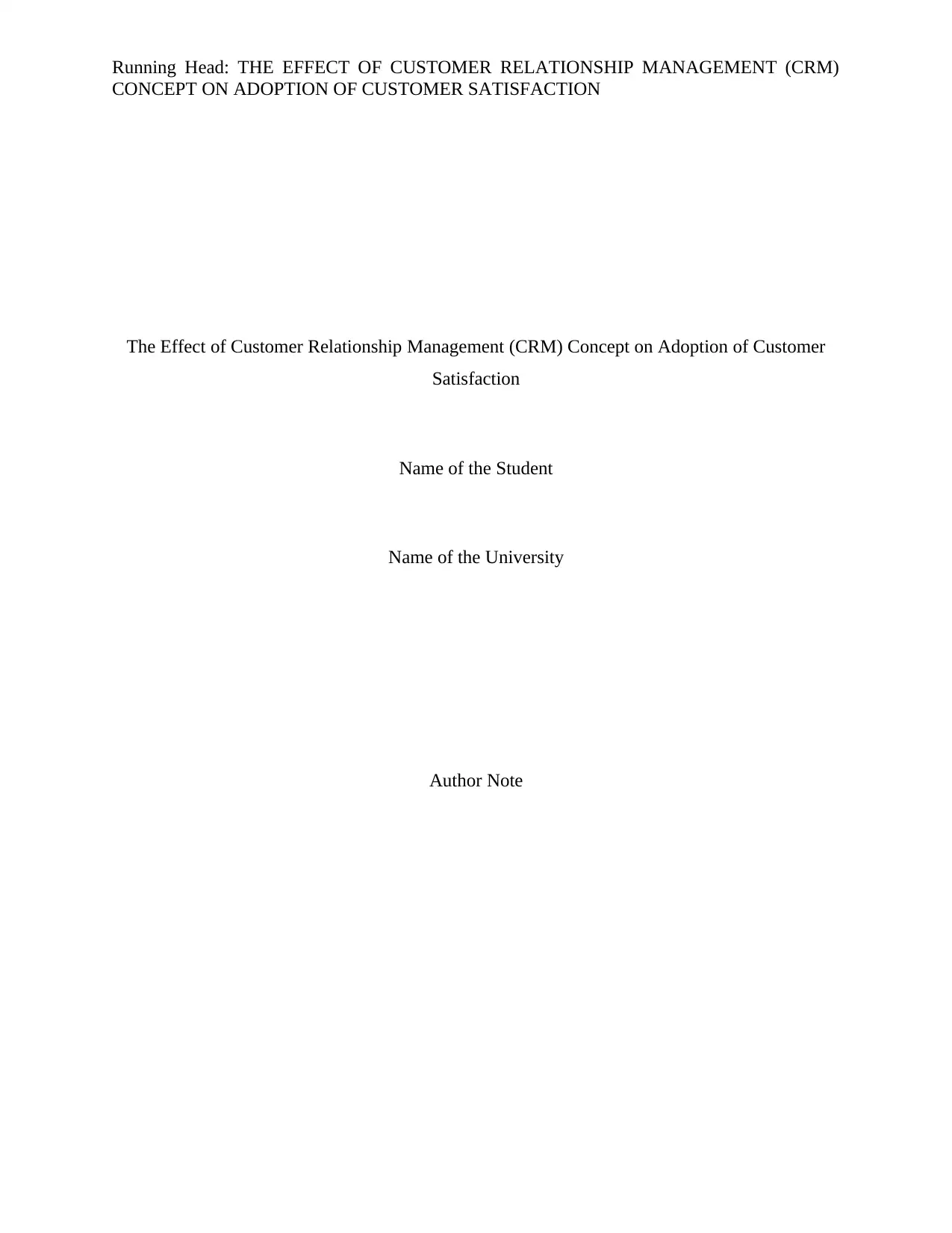
Running Head: THE EFFECT OF CUSTOMER RELATIONSHIP MANAGEMENT (CRM)
CONCEPT ON ADOPTION OF CUSTOMER SATISFACTION
The Effect of Customer Relationship Management (CRM) Concept on Adoption of Customer
Satisfaction
Name of the Student
Name of the University
Author Note
CONCEPT ON ADOPTION OF CUSTOMER SATISFACTION
The Effect of Customer Relationship Management (CRM) Concept on Adoption of Customer
Satisfaction
Name of the Student
Name of the University
Author Note
Paraphrase This Document
Need a fresh take? Get an instant paraphrase of this document with our AI Paraphraser
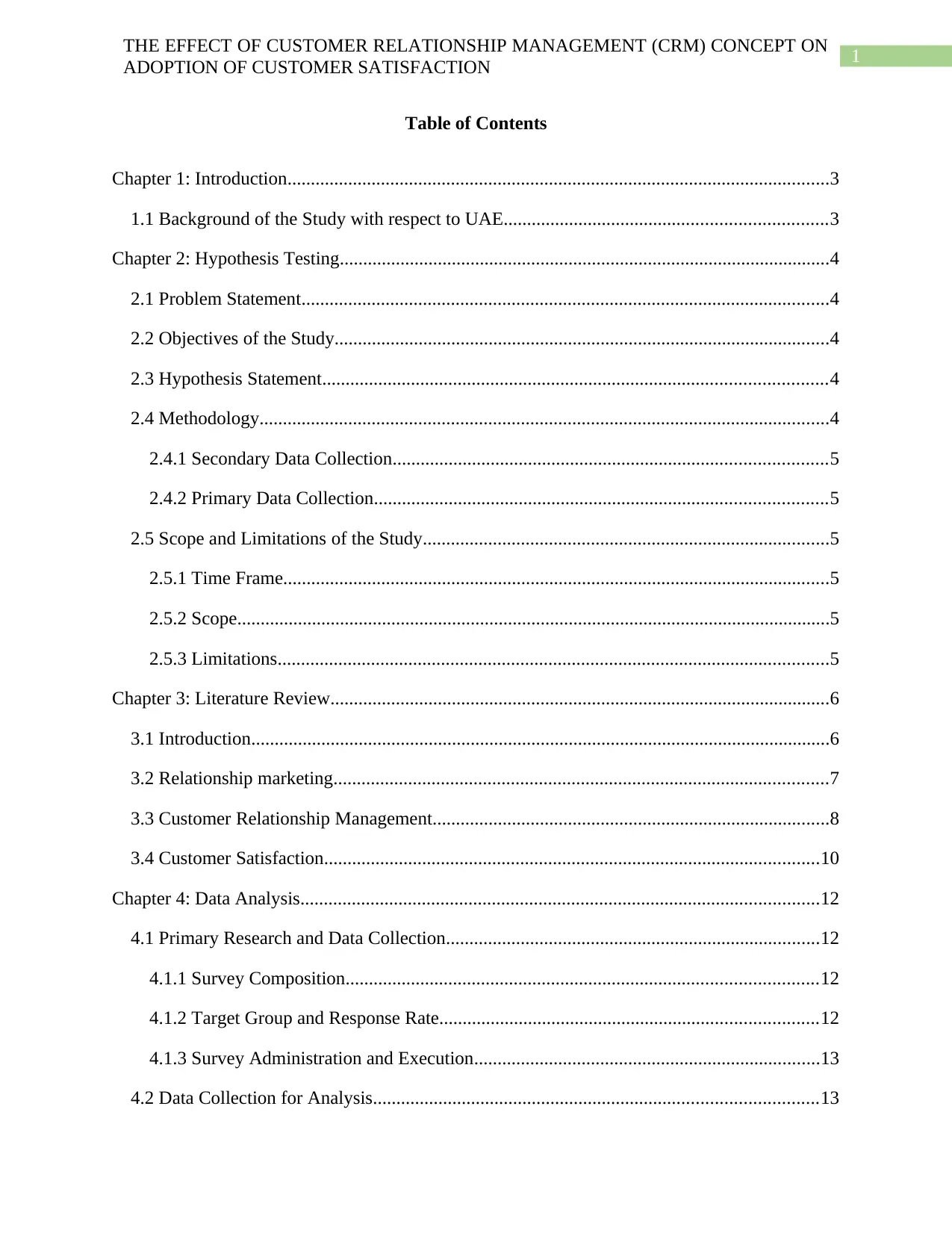
1
THE EFFECT OF CUSTOMER RELATIONSHIP MANAGEMENT (CRM) CONCEPT ON
ADOPTION OF CUSTOMER SATISFACTION
Table of Contents
Chapter 1: Introduction....................................................................................................................3
1.1 Background of the Study with respect to UAE.....................................................................3
Chapter 2: Hypothesis Testing.........................................................................................................4
2.1 Problem Statement.................................................................................................................4
2.2 Objectives of the Study..........................................................................................................4
2.3 Hypothesis Statement............................................................................................................4
2.4 Methodology..........................................................................................................................4
2.4.1 Secondary Data Collection.............................................................................................5
2.4.2 Primary Data Collection.................................................................................................5
2.5 Scope and Limitations of the Study.......................................................................................5
2.5.1 Time Frame.....................................................................................................................5
2.5.2 Scope...............................................................................................................................5
2.5.3 Limitations......................................................................................................................5
Chapter 3: Literature Review...........................................................................................................6
3.1 Introduction............................................................................................................................6
3.2 Relationship marketing..........................................................................................................7
3.3 Customer Relationship Management.....................................................................................8
3.4 Customer Satisfaction..........................................................................................................10
Chapter 4: Data Analysis...............................................................................................................12
4.1 Primary Research and Data Collection................................................................................12
4.1.1 Survey Composition.....................................................................................................12
4.1.2 Target Group and Response Rate.................................................................................12
4.1.3 Survey Administration and Execution..........................................................................13
4.2 Data Collection for Analysis...............................................................................................13
THE EFFECT OF CUSTOMER RELATIONSHIP MANAGEMENT (CRM) CONCEPT ON
ADOPTION OF CUSTOMER SATISFACTION
Table of Contents
Chapter 1: Introduction....................................................................................................................3
1.1 Background of the Study with respect to UAE.....................................................................3
Chapter 2: Hypothesis Testing.........................................................................................................4
2.1 Problem Statement.................................................................................................................4
2.2 Objectives of the Study..........................................................................................................4
2.3 Hypothesis Statement............................................................................................................4
2.4 Methodology..........................................................................................................................4
2.4.1 Secondary Data Collection.............................................................................................5
2.4.2 Primary Data Collection.................................................................................................5
2.5 Scope and Limitations of the Study.......................................................................................5
2.5.1 Time Frame.....................................................................................................................5
2.5.2 Scope...............................................................................................................................5
2.5.3 Limitations......................................................................................................................5
Chapter 3: Literature Review...........................................................................................................6
3.1 Introduction............................................................................................................................6
3.2 Relationship marketing..........................................................................................................7
3.3 Customer Relationship Management.....................................................................................8
3.4 Customer Satisfaction..........................................................................................................10
Chapter 4: Data Analysis...............................................................................................................12
4.1 Primary Research and Data Collection................................................................................12
4.1.1 Survey Composition.....................................................................................................12
4.1.2 Target Group and Response Rate.................................................................................12
4.1.3 Survey Administration and Execution..........................................................................13
4.2 Data Collection for Analysis...............................................................................................13
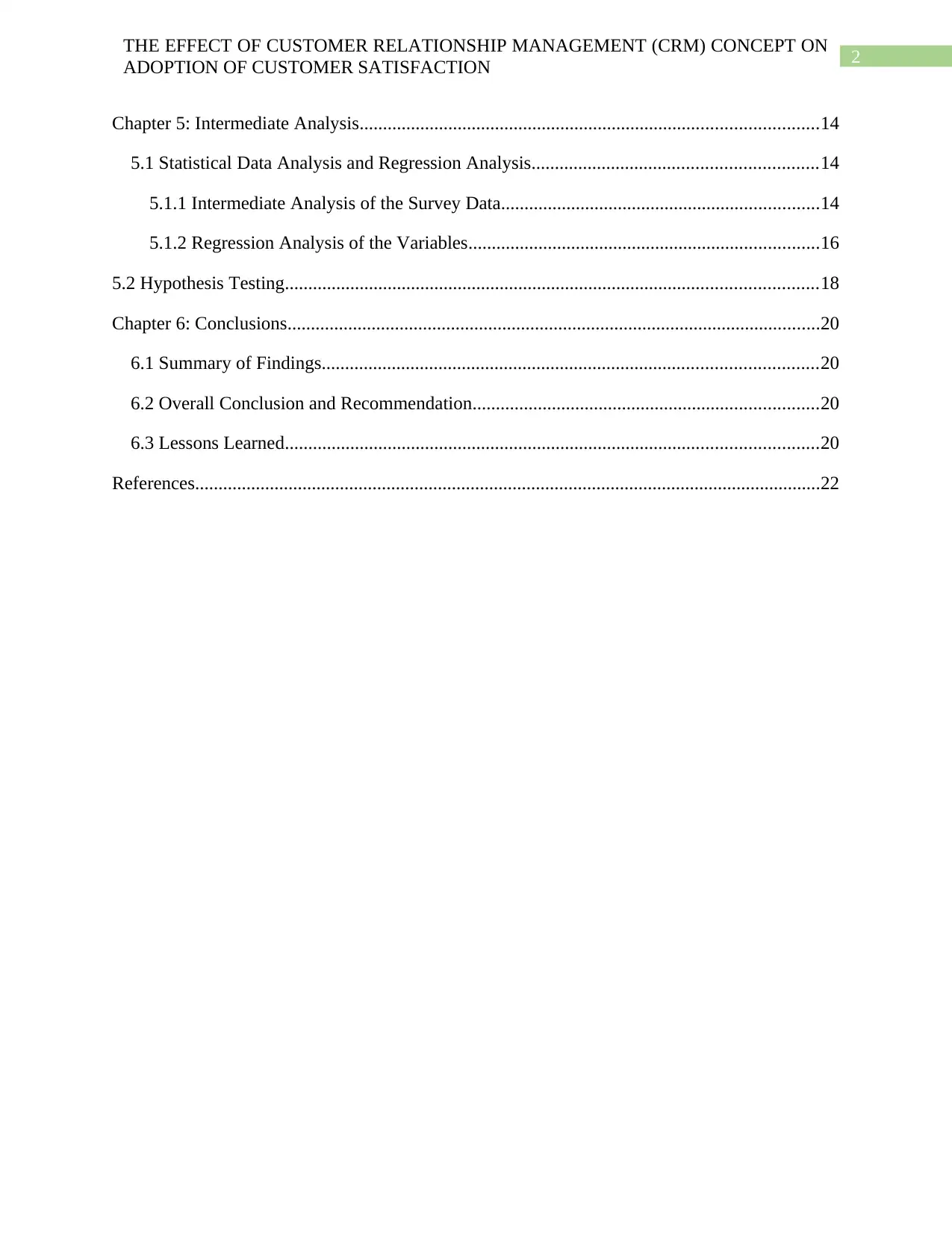
2
THE EFFECT OF CUSTOMER RELATIONSHIP MANAGEMENT (CRM) CONCEPT ON
ADOPTION OF CUSTOMER SATISFACTION
Chapter 5: Intermediate Analysis..................................................................................................14
5.1 Statistical Data Analysis and Regression Analysis.............................................................14
5.1.1 Intermediate Analysis of the Survey Data....................................................................14
5.1.2 Regression Analysis of the Variables...........................................................................16
5.2 Hypothesis Testing..................................................................................................................18
Chapter 6: Conclusions..................................................................................................................20
6.1 Summary of Findings..........................................................................................................20
6.2 Overall Conclusion and Recommendation..........................................................................20
6.3 Lessons Learned..................................................................................................................20
References......................................................................................................................................22
THE EFFECT OF CUSTOMER RELATIONSHIP MANAGEMENT (CRM) CONCEPT ON
ADOPTION OF CUSTOMER SATISFACTION
Chapter 5: Intermediate Analysis..................................................................................................14
5.1 Statistical Data Analysis and Regression Analysis.............................................................14
5.1.1 Intermediate Analysis of the Survey Data....................................................................14
5.1.2 Regression Analysis of the Variables...........................................................................16
5.2 Hypothesis Testing..................................................................................................................18
Chapter 6: Conclusions..................................................................................................................20
6.1 Summary of Findings..........................................................................................................20
6.2 Overall Conclusion and Recommendation..........................................................................20
6.3 Lessons Learned..................................................................................................................20
References......................................................................................................................................22
⊘ This is a preview!⊘
Do you want full access?
Subscribe today to unlock all pages.

Trusted by 1+ million students worldwide
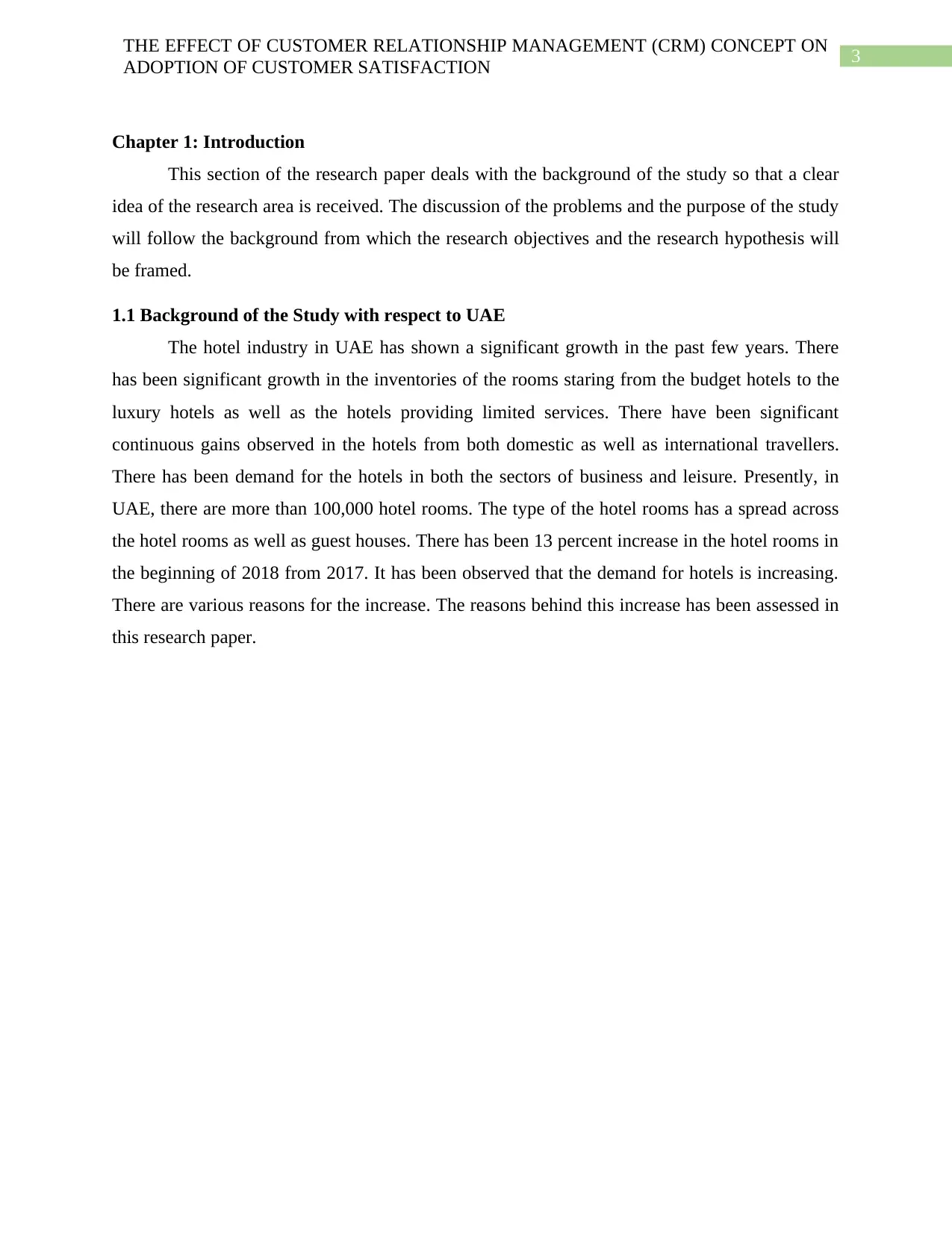
3
THE EFFECT OF CUSTOMER RELATIONSHIP MANAGEMENT (CRM) CONCEPT ON
ADOPTION OF CUSTOMER SATISFACTION
Chapter 1: Introduction
This section of the research paper deals with the background of the study so that a clear
idea of the research area is received. The discussion of the problems and the purpose of the study
will follow the background from which the research objectives and the research hypothesis will
be framed.
1.1 Background of the Study with respect to UAE
The hotel industry in UAE has shown a significant growth in the past few years. There
has been significant growth in the inventories of the rooms staring from the budget hotels to the
luxury hotels as well as the hotels providing limited services. There have been significant
continuous gains observed in the hotels from both domestic as well as international travellers.
There has been demand for the hotels in both the sectors of business and leisure. Presently, in
UAE, there are more than 100,000 hotel rooms. The type of the hotel rooms has a spread across
the hotel rooms as well as guest houses. There has been 13 percent increase in the hotel rooms in
the beginning of 2018 from 2017. It has been observed that the demand for hotels is increasing.
There are various reasons for the increase. The reasons behind this increase has been assessed in
this research paper.
THE EFFECT OF CUSTOMER RELATIONSHIP MANAGEMENT (CRM) CONCEPT ON
ADOPTION OF CUSTOMER SATISFACTION
Chapter 1: Introduction
This section of the research paper deals with the background of the study so that a clear
idea of the research area is received. The discussion of the problems and the purpose of the study
will follow the background from which the research objectives and the research hypothesis will
be framed.
1.1 Background of the Study with respect to UAE
The hotel industry in UAE has shown a significant growth in the past few years. There
has been significant growth in the inventories of the rooms staring from the budget hotels to the
luxury hotels as well as the hotels providing limited services. There have been significant
continuous gains observed in the hotels from both domestic as well as international travellers.
There has been demand for the hotels in both the sectors of business and leisure. Presently, in
UAE, there are more than 100,000 hotel rooms. The type of the hotel rooms has a spread across
the hotel rooms as well as guest houses. There has been 13 percent increase in the hotel rooms in
the beginning of 2018 from 2017. It has been observed that the demand for hotels is increasing.
There are various reasons for the increase. The reasons behind this increase has been assessed in
this research paper.
Paraphrase This Document
Need a fresh take? Get an instant paraphrase of this document with our AI Paraphraser
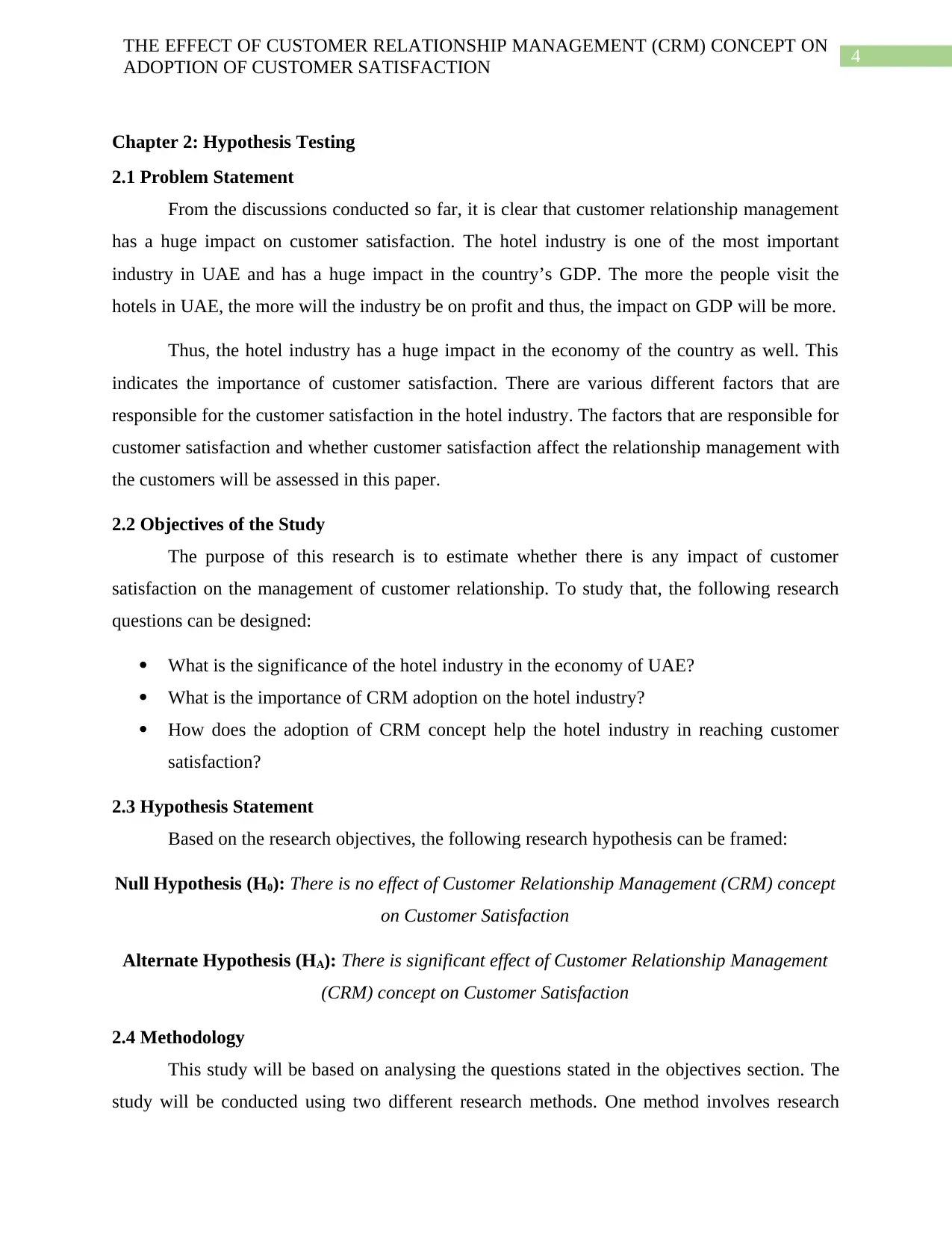
4
THE EFFECT OF CUSTOMER RELATIONSHIP MANAGEMENT (CRM) CONCEPT ON
ADOPTION OF CUSTOMER SATISFACTION
Chapter 2: Hypothesis Testing
2.1 Problem Statement
From the discussions conducted so far, it is clear that customer relationship management
has a huge impact on customer satisfaction. The hotel industry is one of the most important
industry in UAE and has a huge impact in the country’s GDP. The more the people visit the
hotels in UAE, the more will the industry be on profit and thus, the impact on GDP will be more.
Thus, the hotel industry has a huge impact in the economy of the country as well. This
indicates the importance of customer satisfaction. There are various different factors that are
responsible for the customer satisfaction in the hotel industry. The factors that are responsible for
customer satisfaction and whether customer satisfaction affect the relationship management with
the customers will be assessed in this paper.
2.2 Objectives of the Study
The purpose of this research is to estimate whether there is any impact of customer
satisfaction on the management of customer relationship. To study that, the following research
questions can be designed:
What is the significance of the hotel industry in the economy of UAE?
What is the importance of CRM adoption on the hotel industry?
How does the adoption of CRM concept help the hotel industry in reaching customer
satisfaction?
2.3 Hypothesis Statement
Based on the research objectives, the following research hypothesis can be framed:
Null Hypothesis (H0): There is no effect of Customer Relationship Management (CRM) concept
on Customer Satisfaction
Alternate Hypothesis (HA): There is significant effect of Customer Relationship Management
(CRM) concept on Customer Satisfaction
2.4 Methodology
This study will be based on analysing the questions stated in the objectives section. The
study will be conducted using two different research methods. One method involves research
THE EFFECT OF CUSTOMER RELATIONSHIP MANAGEMENT (CRM) CONCEPT ON
ADOPTION OF CUSTOMER SATISFACTION
Chapter 2: Hypothesis Testing
2.1 Problem Statement
From the discussions conducted so far, it is clear that customer relationship management
has a huge impact on customer satisfaction. The hotel industry is one of the most important
industry in UAE and has a huge impact in the country’s GDP. The more the people visit the
hotels in UAE, the more will the industry be on profit and thus, the impact on GDP will be more.
Thus, the hotel industry has a huge impact in the economy of the country as well. This
indicates the importance of customer satisfaction. There are various different factors that are
responsible for the customer satisfaction in the hotel industry. The factors that are responsible for
customer satisfaction and whether customer satisfaction affect the relationship management with
the customers will be assessed in this paper.
2.2 Objectives of the Study
The purpose of this research is to estimate whether there is any impact of customer
satisfaction on the management of customer relationship. To study that, the following research
questions can be designed:
What is the significance of the hotel industry in the economy of UAE?
What is the importance of CRM adoption on the hotel industry?
How does the adoption of CRM concept help the hotel industry in reaching customer
satisfaction?
2.3 Hypothesis Statement
Based on the research objectives, the following research hypothesis can be framed:
Null Hypothesis (H0): There is no effect of Customer Relationship Management (CRM) concept
on Customer Satisfaction
Alternate Hypothesis (HA): There is significant effect of Customer Relationship Management
(CRM) concept on Customer Satisfaction
2.4 Methodology
This study will be based on analysing the questions stated in the objectives section. The
study will be conducted using two different research methods. One method involves research
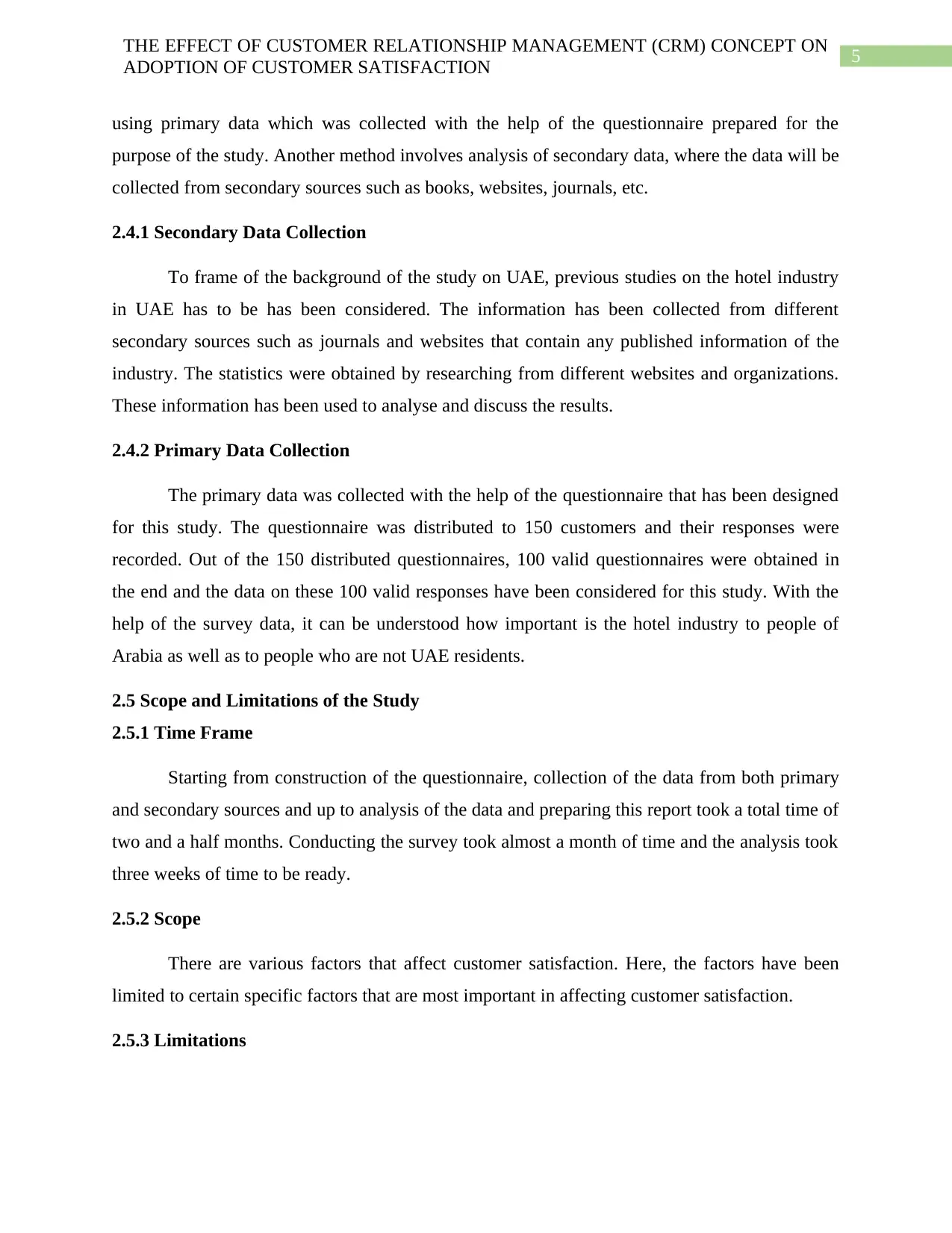
5
THE EFFECT OF CUSTOMER RELATIONSHIP MANAGEMENT (CRM) CONCEPT ON
ADOPTION OF CUSTOMER SATISFACTION
using primary data which was collected with the help of the questionnaire prepared for the
purpose of the study. Another method involves analysis of secondary data, where the data will be
collected from secondary sources such as books, websites, journals, etc.
2.4.1 Secondary Data Collection
To frame of the background of the study on UAE, previous studies on the hotel industry
in UAE has to be has been considered. The information has been collected from different
secondary sources such as journals and websites that contain any published information of the
industry. The statistics were obtained by researching from different websites and organizations.
These information has been used to analyse and discuss the results.
2.4.2 Primary Data Collection
The primary data was collected with the help of the questionnaire that has been designed
for this study. The questionnaire was distributed to 150 customers and their responses were
recorded. Out of the 150 distributed questionnaires, 100 valid questionnaires were obtained in
the end and the data on these 100 valid responses have been considered for this study. With the
help of the survey data, it can be understood how important is the hotel industry to people of
Arabia as well as to people who are not UAE residents.
2.5 Scope and Limitations of the Study
2.5.1 Time Frame
Starting from construction of the questionnaire, collection of the data from both primary
and secondary sources and up to analysis of the data and preparing this report took a total time of
two and a half months. Conducting the survey took almost a month of time and the analysis took
three weeks of time to be ready.
2.5.2 Scope
There are various factors that affect customer satisfaction. Here, the factors have been
limited to certain specific factors that are most important in affecting customer satisfaction.
2.5.3 Limitations
THE EFFECT OF CUSTOMER RELATIONSHIP MANAGEMENT (CRM) CONCEPT ON
ADOPTION OF CUSTOMER SATISFACTION
using primary data which was collected with the help of the questionnaire prepared for the
purpose of the study. Another method involves analysis of secondary data, where the data will be
collected from secondary sources such as books, websites, journals, etc.
2.4.1 Secondary Data Collection
To frame of the background of the study on UAE, previous studies on the hotel industry
in UAE has to be has been considered. The information has been collected from different
secondary sources such as journals and websites that contain any published information of the
industry. The statistics were obtained by researching from different websites and organizations.
These information has been used to analyse and discuss the results.
2.4.2 Primary Data Collection
The primary data was collected with the help of the questionnaire that has been designed
for this study. The questionnaire was distributed to 150 customers and their responses were
recorded. Out of the 150 distributed questionnaires, 100 valid questionnaires were obtained in
the end and the data on these 100 valid responses have been considered for this study. With the
help of the survey data, it can be understood how important is the hotel industry to people of
Arabia as well as to people who are not UAE residents.
2.5 Scope and Limitations of the Study
2.5.1 Time Frame
Starting from construction of the questionnaire, collection of the data from both primary
and secondary sources and up to analysis of the data and preparing this report took a total time of
two and a half months. Conducting the survey took almost a month of time and the analysis took
three weeks of time to be ready.
2.5.2 Scope
There are various factors that affect customer satisfaction. Here, the factors have been
limited to certain specific factors that are most important in affecting customer satisfaction.
2.5.3 Limitations
⊘ This is a preview!⊘
Do you want full access?
Subscribe today to unlock all pages.

Trusted by 1+ million students worldwide
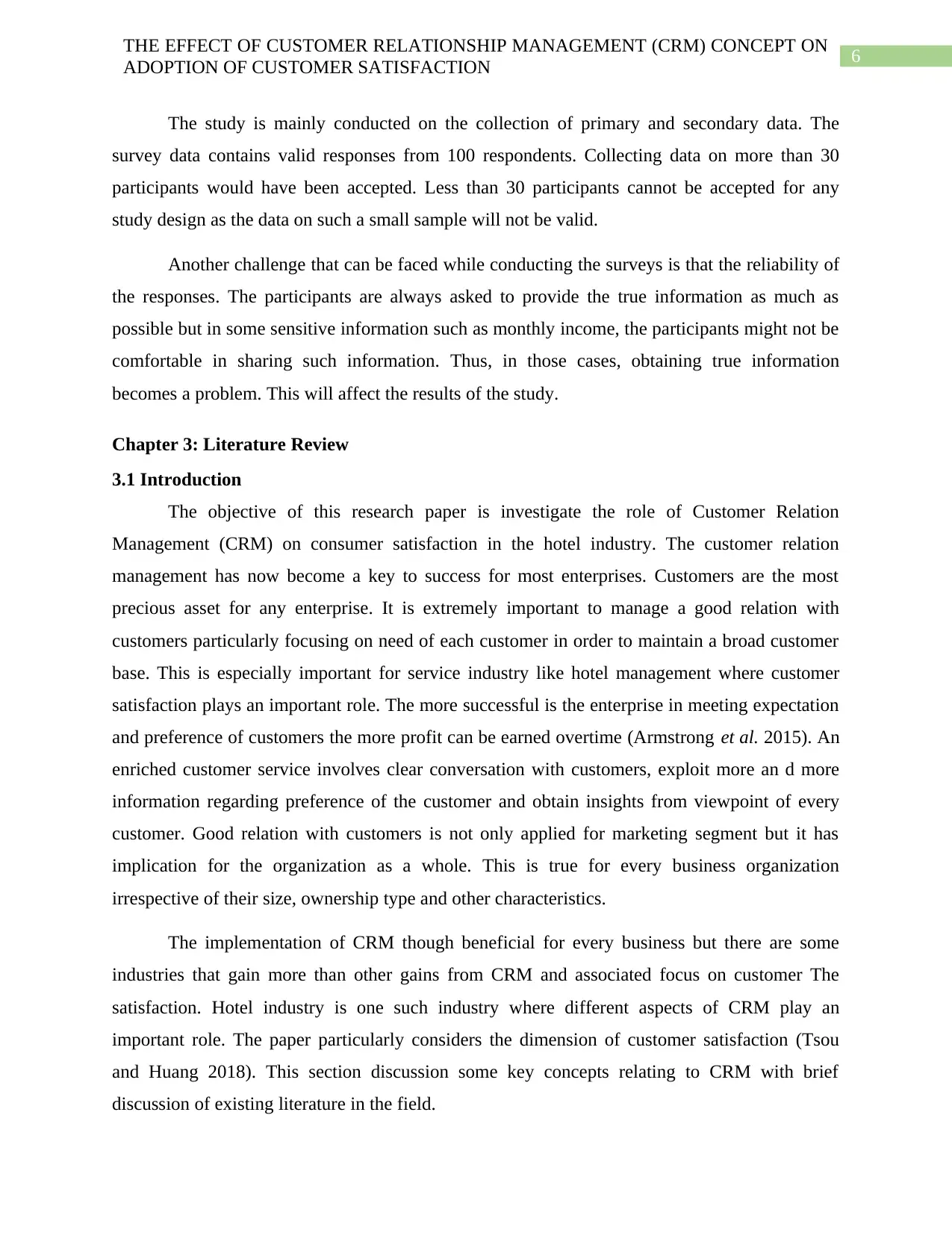
6
THE EFFECT OF CUSTOMER RELATIONSHIP MANAGEMENT (CRM) CONCEPT ON
ADOPTION OF CUSTOMER SATISFACTION
The study is mainly conducted on the collection of primary and secondary data. The
survey data contains valid responses from 100 respondents. Collecting data on more than 30
participants would have been accepted. Less than 30 participants cannot be accepted for any
study design as the data on such a small sample will not be valid.
Another challenge that can be faced while conducting the surveys is that the reliability of
the responses. The participants are always asked to provide the true information as much as
possible but in some sensitive information such as monthly income, the participants might not be
comfortable in sharing such information. Thus, in those cases, obtaining true information
becomes a problem. This will affect the results of the study.
Chapter 3: Literature Review
3.1 Introduction
The objective of this research paper is investigate the role of Customer Relation
Management (CRM) on consumer satisfaction in the hotel industry. The customer relation
management has now become a key to success for most enterprises. Customers are the most
precious asset for any enterprise. It is extremely important to manage a good relation with
customers particularly focusing on need of each customer in order to maintain a broad customer
base. This is especially important for service industry like hotel management where customer
satisfaction plays an important role. The more successful is the enterprise in meeting expectation
and preference of customers the more profit can be earned overtime (Armstrong et al. 2015). An
enriched customer service involves clear conversation with customers, exploit more an d more
information regarding preference of the customer and obtain insights from viewpoint of every
customer. Good relation with customers is not only applied for marketing segment but it has
implication for the organization as a whole. This is true for every business organization
irrespective of their size, ownership type and other characteristics.
The implementation of CRM though beneficial for every business but there are some
industries that gain more than other gains from CRM and associated focus on customer The
satisfaction. Hotel industry is one such industry where different aspects of CRM play an
important role. The paper particularly considers the dimension of customer satisfaction (Tsou
and Huang 2018). This section discussion some key concepts relating to CRM with brief
discussion of existing literature in the field.
THE EFFECT OF CUSTOMER RELATIONSHIP MANAGEMENT (CRM) CONCEPT ON
ADOPTION OF CUSTOMER SATISFACTION
The study is mainly conducted on the collection of primary and secondary data. The
survey data contains valid responses from 100 respondents. Collecting data on more than 30
participants would have been accepted. Less than 30 participants cannot be accepted for any
study design as the data on such a small sample will not be valid.
Another challenge that can be faced while conducting the surveys is that the reliability of
the responses. The participants are always asked to provide the true information as much as
possible but in some sensitive information such as monthly income, the participants might not be
comfortable in sharing such information. Thus, in those cases, obtaining true information
becomes a problem. This will affect the results of the study.
Chapter 3: Literature Review
3.1 Introduction
The objective of this research paper is investigate the role of Customer Relation
Management (CRM) on consumer satisfaction in the hotel industry. The customer relation
management has now become a key to success for most enterprises. Customers are the most
precious asset for any enterprise. It is extremely important to manage a good relation with
customers particularly focusing on need of each customer in order to maintain a broad customer
base. This is especially important for service industry like hotel management where customer
satisfaction plays an important role. The more successful is the enterprise in meeting expectation
and preference of customers the more profit can be earned overtime (Armstrong et al. 2015). An
enriched customer service involves clear conversation with customers, exploit more an d more
information regarding preference of the customer and obtain insights from viewpoint of every
customer. Good relation with customers is not only applied for marketing segment but it has
implication for the organization as a whole. This is true for every business organization
irrespective of their size, ownership type and other characteristics.
The implementation of CRM though beneficial for every business but there are some
industries that gain more than other gains from CRM and associated focus on customer The
satisfaction. Hotel industry is one such industry where different aspects of CRM play an
important role. The paper particularly considers the dimension of customer satisfaction (Tsou
and Huang 2018). This section discussion some key concepts relating to CRM with brief
discussion of existing literature in the field.
Paraphrase This Document
Need a fresh take? Get an instant paraphrase of this document with our AI Paraphraser
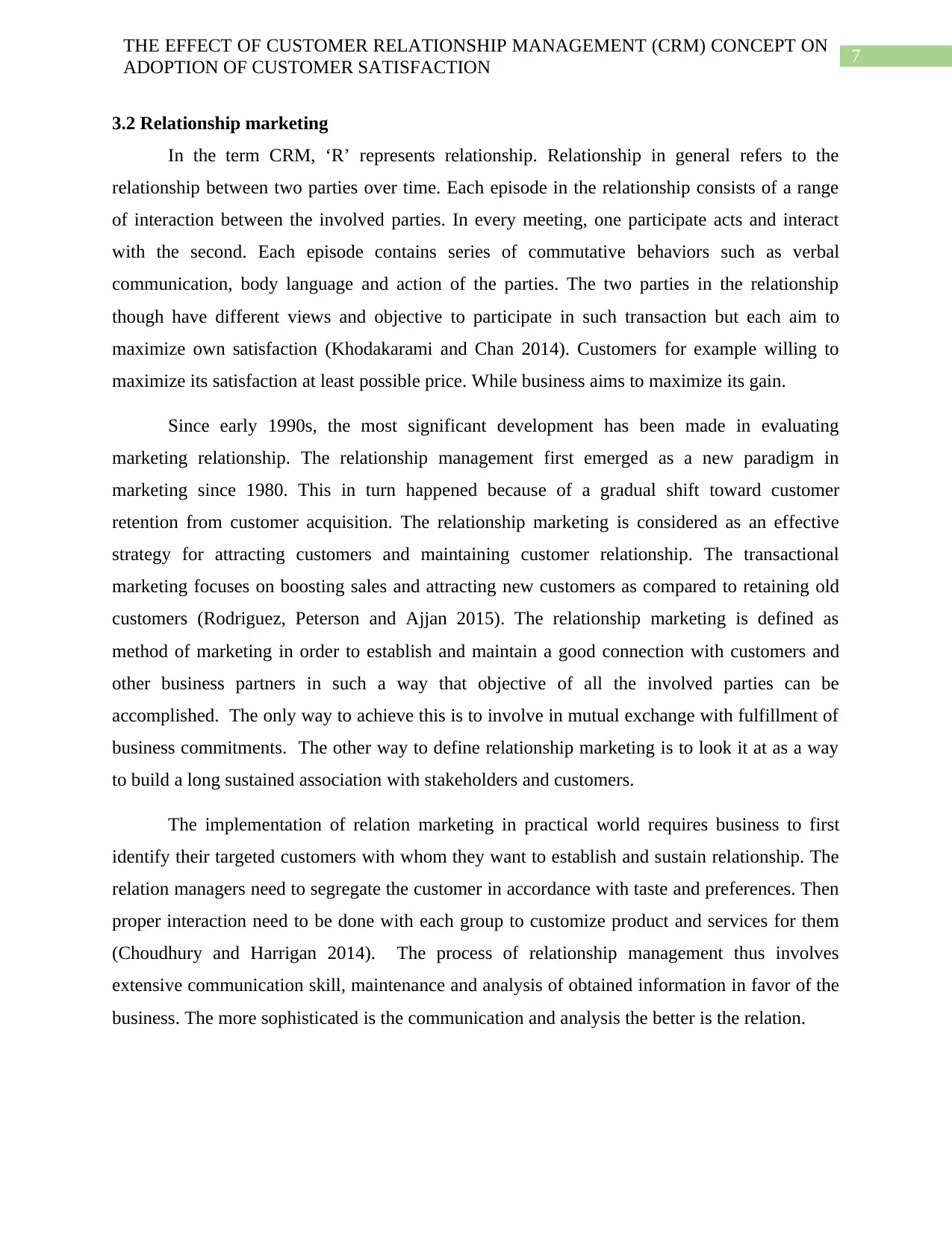
7
THE EFFECT OF CUSTOMER RELATIONSHIP MANAGEMENT (CRM) CONCEPT ON
ADOPTION OF CUSTOMER SATISFACTION
3.2 Relationship marketing
In the term CRM, ‘R’ represents relationship. Relationship in general refers to the
relationship between two parties over time. Each episode in the relationship consists of a range
of interaction between the involved parties. In every meeting, one participate acts and interact
with the second. Each episode contains series of commutative behaviors such as verbal
communication, body language and action of the parties. The two parties in the relationship
though have different views and objective to participate in such transaction but each aim to
maximize own satisfaction (Khodakarami and Chan 2014). Customers for example willing to
maximize its satisfaction at least possible price. While business aims to maximize its gain.
Since early 1990s, the most significant development has been made in evaluating
marketing relationship. The relationship management first emerged as a new paradigm in
marketing since 1980. This in turn happened because of a gradual shift toward customer
retention from customer acquisition. The relationship marketing is considered as an effective
strategy for attracting customers and maintaining customer relationship. The transactional
marketing focuses on boosting sales and attracting new customers as compared to retaining old
customers (Rodriguez, Peterson and Ajjan 2015). The relationship marketing is defined as
method of marketing in order to establish and maintain a good connection with customers and
other business partners in such a way that objective of all the involved parties can be
accomplished. The only way to achieve this is to involve in mutual exchange with fulfillment of
business commitments. The other way to define relationship marketing is to look it at as a way
to build a long sustained association with stakeholders and customers.
The implementation of relation marketing in practical world requires business to first
identify their targeted customers with whom they want to establish and sustain relationship. The
relation managers need to segregate the customer in accordance with taste and preferences. Then
proper interaction need to be done with each group to customize product and services for them
(Choudhury and Harrigan 2014). The process of relationship management thus involves
extensive communication skill, maintenance and analysis of obtained information in favor of the
business. The more sophisticated is the communication and analysis the better is the relation.
THE EFFECT OF CUSTOMER RELATIONSHIP MANAGEMENT (CRM) CONCEPT ON
ADOPTION OF CUSTOMER SATISFACTION
3.2 Relationship marketing
In the term CRM, ‘R’ represents relationship. Relationship in general refers to the
relationship between two parties over time. Each episode in the relationship consists of a range
of interaction between the involved parties. In every meeting, one participate acts and interact
with the second. Each episode contains series of commutative behaviors such as verbal
communication, body language and action of the parties. The two parties in the relationship
though have different views and objective to participate in such transaction but each aim to
maximize own satisfaction (Khodakarami and Chan 2014). Customers for example willing to
maximize its satisfaction at least possible price. While business aims to maximize its gain.
Since early 1990s, the most significant development has been made in evaluating
marketing relationship. The relationship management first emerged as a new paradigm in
marketing since 1980. This in turn happened because of a gradual shift toward customer
retention from customer acquisition. The relationship marketing is considered as an effective
strategy for attracting customers and maintaining customer relationship. The transactional
marketing focuses on boosting sales and attracting new customers as compared to retaining old
customers (Rodriguez, Peterson and Ajjan 2015). The relationship marketing is defined as
method of marketing in order to establish and maintain a good connection with customers and
other business partners in such a way that objective of all the involved parties can be
accomplished. The only way to achieve this is to involve in mutual exchange with fulfillment of
business commitments. The other way to define relationship marketing is to look it at as a way
to build a long sustained association with stakeholders and customers.
The implementation of relation marketing in practical world requires business to first
identify their targeted customers with whom they want to establish and sustain relationship. The
relation managers need to segregate the customer in accordance with taste and preferences. Then
proper interaction need to be done with each group to customize product and services for them
(Choudhury and Harrigan 2014). The process of relationship management thus involves
extensive communication skill, maintenance and analysis of obtained information in favor of the
business. The more sophisticated is the communication and analysis the better is the relation.
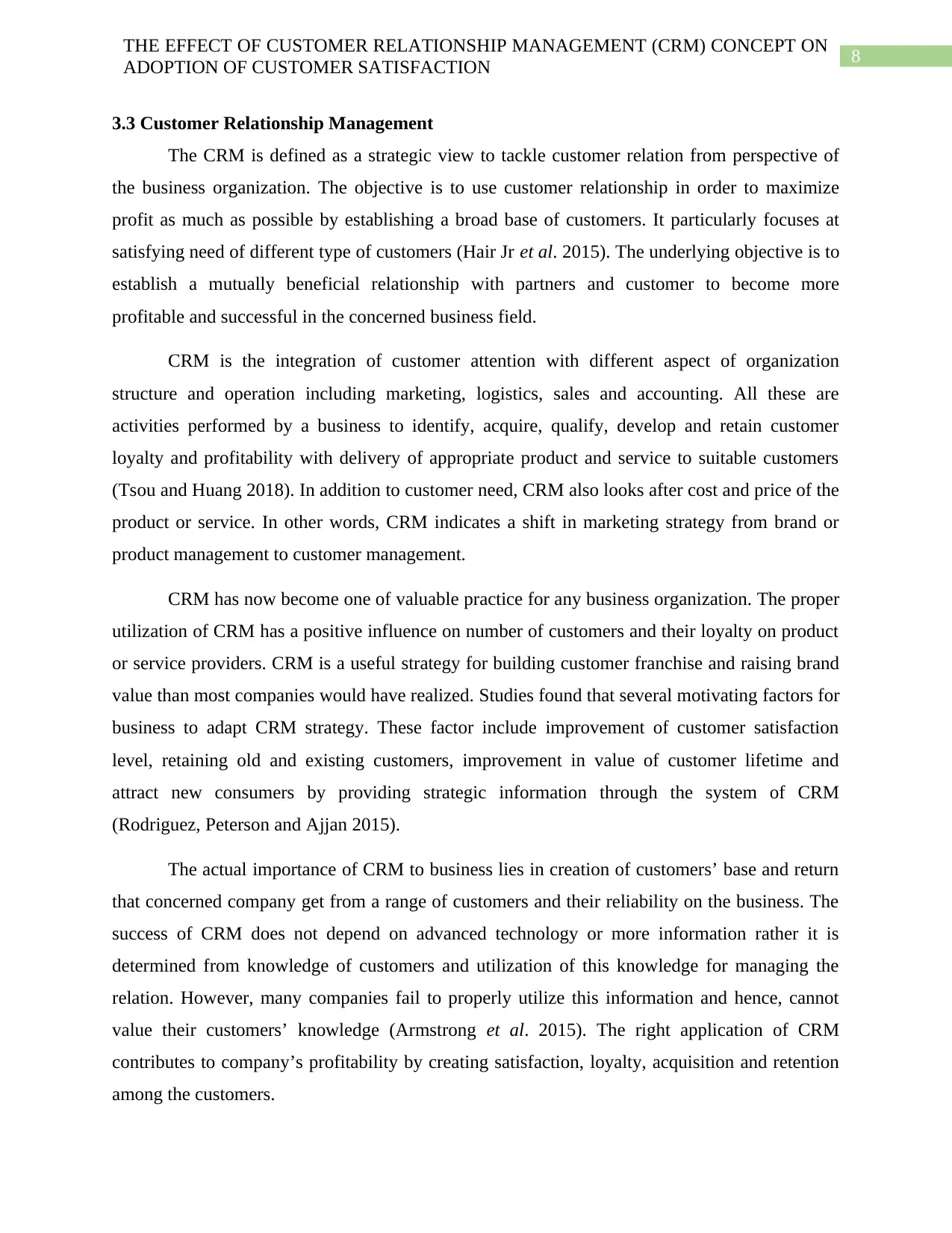
8
THE EFFECT OF CUSTOMER RELATIONSHIP MANAGEMENT (CRM) CONCEPT ON
ADOPTION OF CUSTOMER SATISFACTION
3.3 Customer Relationship Management
The CRM is defined as a strategic view to tackle customer relation from perspective of
the business organization. The objective is to use customer relationship in order to maximize
profit as much as possible by establishing a broad base of customers. It particularly focuses at
satisfying need of different type of customers (Hair Jr et al. 2015). The underlying objective is to
establish a mutually beneficial relationship with partners and customer to become more
profitable and successful in the concerned business field.
CRM is the integration of customer attention with different aspect of organization
structure and operation including marketing, logistics, sales and accounting. All these are
activities performed by a business to identify, acquire, qualify, develop and retain customer
loyalty and profitability with delivery of appropriate product and service to suitable customers
(Tsou and Huang 2018). In addition to customer need, CRM also looks after cost and price of the
product or service. In other words, CRM indicates a shift in marketing strategy from brand or
product management to customer management.
CRM has now become one of valuable practice for any business organization. The proper
utilization of CRM has a positive influence on number of customers and their loyalty on product
or service providers. CRM is a useful strategy for building customer franchise and raising brand
value than most companies would have realized. Studies found that several motivating factors for
business to adapt CRM strategy. These factor include improvement of customer satisfaction
level, retaining old and existing customers, improvement in value of customer lifetime and
attract new consumers by providing strategic information through the system of CRM
(Rodriguez, Peterson and Ajjan 2015).
The actual importance of CRM to business lies in creation of customers’ base and return
that concerned company get from a range of customers and their reliability on the business. The
success of CRM does not depend on advanced technology or more information rather it is
determined from knowledge of customers and utilization of this knowledge for managing the
relation. However, many companies fail to properly utilize this information and hence, cannot
value their customers’ knowledge (Armstrong et al. 2015). The right application of CRM
contributes to company’s profitability by creating satisfaction, loyalty, acquisition and retention
among the customers.
THE EFFECT OF CUSTOMER RELATIONSHIP MANAGEMENT (CRM) CONCEPT ON
ADOPTION OF CUSTOMER SATISFACTION
3.3 Customer Relationship Management
The CRM is defined as a strategic view to tackle customer relation from perspective of
the business organization. The objective is to use customer relationship in order to maximize
profit as much as possible by establishing a broad base of customers. It particularly focuses at
satisfying need of different type of customers (Hair Jr et al. 2015). The underlying objective is to
establish a mutually beneficial relationship with partners and customer to become more
profitable and successful in the concerned business field.
CRM is the integration of customer attention with different aspect of organization
structure and operation including marketing, logistics, sales and accounting. All these are
activities performed by a business to identify, acquire, qualify, develop and retain customer
loyalty and profitability with delivery of appropriate product and service to suitable customers
(Tsou and Huang 2018). In addition to customer need, CRM also looks after cost and price of the
product or service. In other words, CRM indicates a shift in marketing strategy from brand or
product management to customer management.
CRM has now become one of valuable practice for any business organization. The proper
utilization of CRM has a positive influence on number of customers and their loyalty on product
or service providers. CRM is a useful strategy for building customer franchise and raising brand
value than most companies would have realized. Studies found that several motivating factors for
business to adapt CRM strategy. These factor include improvement of customer satisfaction
level, retaining old and existing customers, improvement in value of customer lifetime and
attract new consumers by providing strategic information through the system of CRM
(Rodriguez, Peterson and Ajjan 2015).
The actual importance of CRM to business lies in creation of customers’ base and return
that concerned company get from a range of customers and their reliability on the business. The
success of CRM does not depend on advanced technology or more information rather it is
determined from knowledge of customers and utilization of this knowledge for managing the
relation. However, many companies fail to properly utilize this information and hence, cannot
value their customers’ knowledge (Armstrong et al. 2015). The right application of CRM
contributes to company’s profitability by creating satisfaction, loyalty, acquisition and retention
among the customers.
⊘ This is a preview!⊘
Do you want full access?
Subscribe today to unlock all pages.

Trusted by 1+ million students worldwide
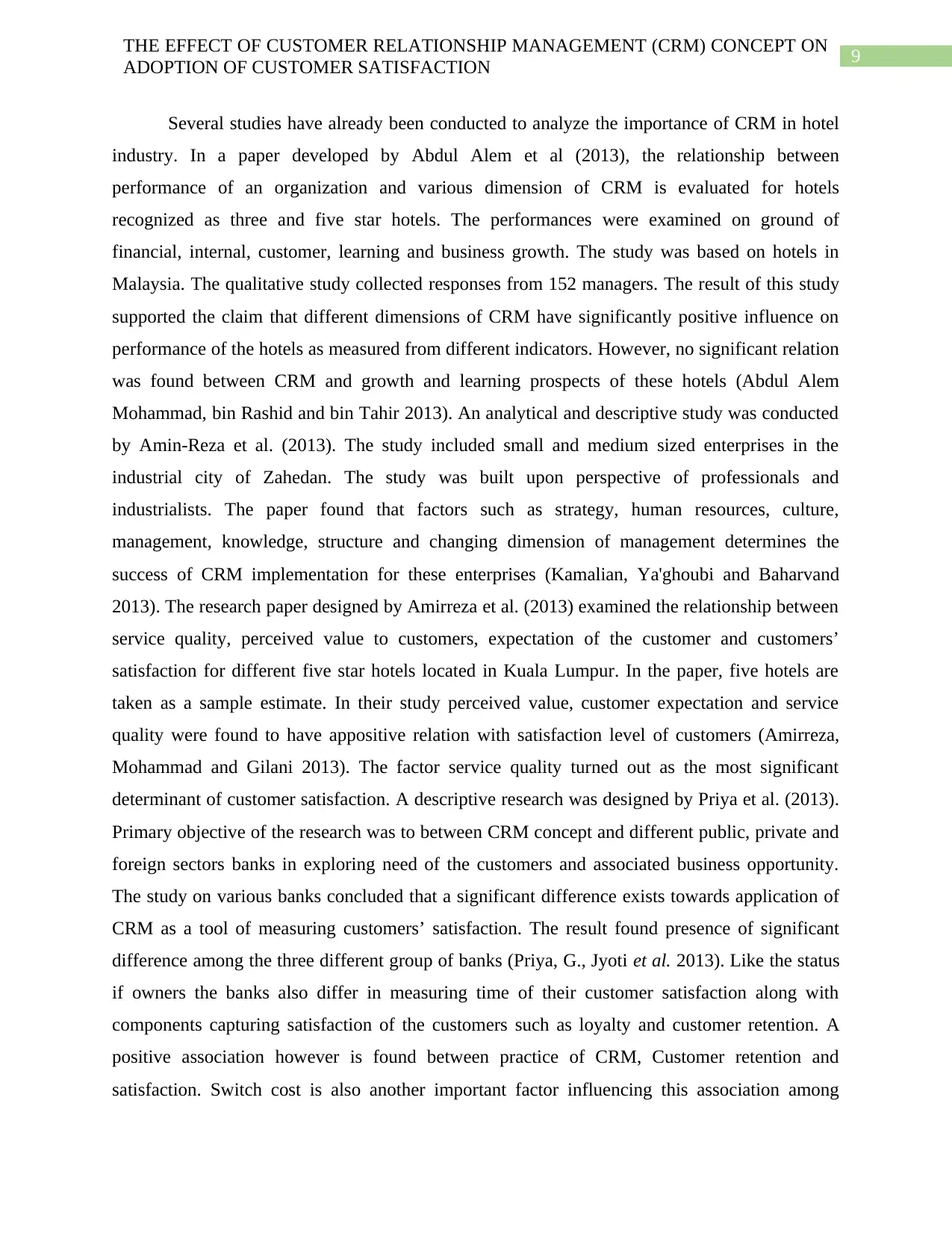
9
THE EFFECT OF CUSTOMER RELATIONSHIP MANAGEMENT (CRM) CONCEPT ON
ADOPTION OF CUSTOMER SATISFACTION
Several studies have already been conducted to analyze the importance of CRM in hotel
industry. In a paper developed by Abdul Alem et al (2013), the relationship between
performance of an organization and various dimension of CRM is evaluated for hotels
recognized as three and five star hotels. The performances were examined on ground of
financial, internal, customer, learning and business growth. The study was based on hotels in
Malaysia. The qualitative study collected responses from 152 managers. The result of this study
supported the claim that different dimensions of CRM have significantly positive influence on
performance of the hotels as measured from different indicators. However, no significant relation
was found between CRM and growth and learning prospects of these hotels (Abdul Alem
Mohammad, bin Rashid and bin Tahir 2013). An analytical and descriptive study was conducted
by Amin-Reza et al. (2013). The study included small and medium sized enterprises in the
industrial city of Zahedan. The study was built upon perspective of professionals and
industrialists. The paper found that factors such as strategy, human resources, culture,
management, knowledge, structure and changing dimension of management determines the
success of CRM implementation for these enterprises (Kamalian, Ya'ghoubi and Baharvand
2013). The research paper designed by Amirreza et al. (2013) examined the relationship between
service quality, perceived value to customers, expectation of the customer and customers’
satisfaction for different five star hotels located in Kuala Lumpur. In the paper, five hotels are
taken as a sample estimate. In their study perceived value, customer expectation and service
quality were found to have appositive relation with satisfaction level of customers (Amirreza,
Mohammad and Gilani 2013). The factor service quality turned out as the most significant
determinant of customer satisfaction. A descriptive research was designed by Priya et al. (2013).
Primary objective of the research was to between CRM concept and different public, private and
foreign sectors banks in exploring need of the customers and associated business opportunity.
The study on various banks concluded that a significant difference exists towards application of
CRM as a tool of measuring customers’ satisfaction. The result found presence of significant
difference among the three different group of banks (Priya, G., Jyoti et al. 2013). Like the status
if owners the banks also differ in measuring time of their customer satisfaction along with
components capturing satisfaction of the customers such as loyalty and customer retention. A
positive association however is found between practice of CRM, Customer retention and
satisfaction. Switch cost is also another important factor influencing this association among
THE EFFECT OF CUSTOMER RELATIONSHIP MANAGEMENT (CRM) CONCEPT ON
ADOPTION OF CUSTOMER SATISFACTION
Several studies have already been conducted to analyze the importance of CRM in hotel
industry. In a paper developed by Abdul Alem et al (2013), the relationship between
performance of an organization and various dimension of CRM is evaluated for hotels
recognized as three and five star hotels. The performances were examined on ground of
financial, internal, customer, learning and business growth. The study was based on hotels in
Malaysia. The qualitative study collected responses from 152 managers. The result of this study
supported the claim that different dimensions of CRM have significantly positive influence on
performance of the hotels as measured from different indicators. However, no significant relation
was found between CRM and growth and learning prospects of these hotels (Abdul Alem
Mohammad, bin Rashid and bin Tahir 2013). An analytical and descriptive study was conducted
by Amin-Reza et al. (2013). The study included small and medium sized enterprises in the
industrial city of Zahedan. The study was built upon perspective of professionals and
industrialists. The paper found that factors such as strategy, human resources, culture,
management, knowledge, structure and changing dimension of management determines the
success of CRM implementation for these enterprises (Kamalian, Ya'ghoubi and Baharvand
2013). The research paper designed by Amirreza et al. (2013) examined the relationship between
service quality, perceived value to customers, expectation of the customer and customers’
satisfaction for different five star hotels located in Kuala Lumpur. In the paper, five hotels are
taken as a sample estimate. In their study perceived value, customer expectation and service
quality were found to have appositive relation with satisfaction level of customers (Amirreza,
Mohammad and Gilani 2013). The factor service quality turned out as the most significant
determinant of customer satisfaction. A descriptive research was designed by Priya et al. (2013).
Primary objective of the research was to between CRM concept and different public, private and
foreign sectors banks in exploring need of the customers and associated business opportunity.
The study on various banks concluded that a significant difference exists towards application of
CRM as a tool of measuring customers’ satisfaction. The result found presence of significant
difference among the three different group of banks (Priya, G., Jyoti et al. 2013). Like the status
if owners the banks also differ in measuring time of their customer satisfaction along with
components capturing satisfaction of the customers such as loyalty and customer retention. A
positive association however is found between practice of CRM, Customer retention and
satisfaction. Switch cost is also another important factor influencing this association among
Paraphrase This Document
Need a fresh take? Get an instant paraphrase of this document with our AI Paraphraser
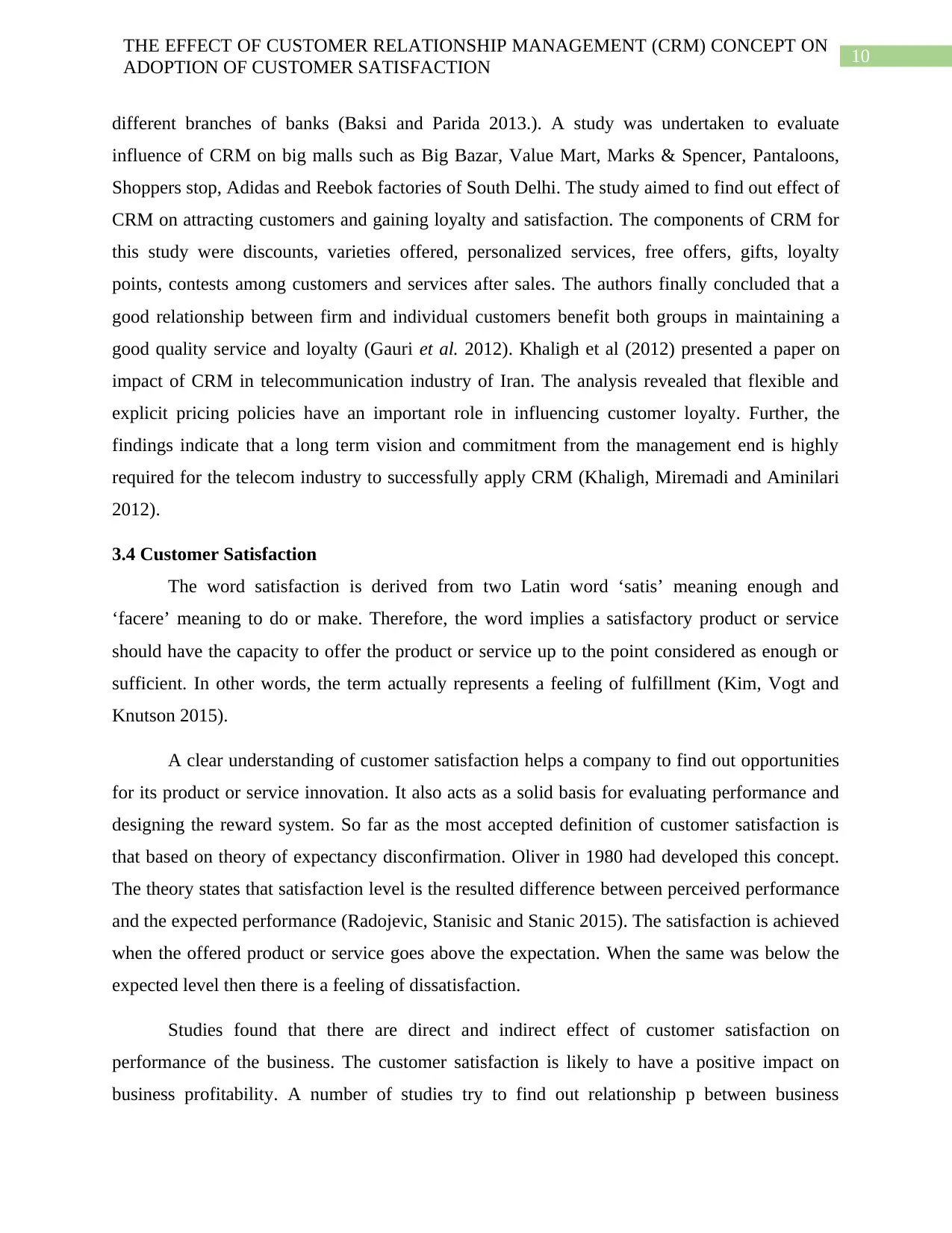
10
THE EFFECT OF CUSTOMER RELATIONSHIP MANAGEMENT (CRM) CONCEPT ON
ADOPTION OF CUSTOMER SATISFACTION
different branches of banks (Baksi and Parida 2013.). A study was undertaken to evaluate
influence of CRM on big malls such as Big Bazar, Value Mart, Marks & Spencer, Pantaloons,
Shoppers stop, Adidas and Reebok factories of South Delhi. The study aimed to find out effect of
CRM on attracting customers and gaining loyalty and satisfaction. The components of CRM for
this study were discounts, varieties offered, personalized services, free offers, gifts, loyalty
points, contests among customers and services after sales. The authors finally concluded that a
good relationship between firm and individual customers benefit both groups in maintaining a
good quality service and loyalty (Gauri et al. 2012). Khaligh et al (2012) presented a paper on
impact of CRM in telecommunication industry of Iran. The analysis revealed that flexible and
explicit pricing policies have an important role in influencing customer loyalty. Further, the
findings indicate that a long term vision and commitment from the management end is highly
required for the telecom industry to successfully apply CRM (Khaligh, Miremadi and Aminilari
2012).
3.4 Customer Satisfaction
The word satisfaction is derived from two Latin word ‘satis’ meaning enough and
‘facere’ meaning to do or make. Therefore, the word implies a satisfactory product or service
should have the capacity to offer the product or service up to the point considered as enough or
sufficient. In other words, the term actually represents a feeling of fulfillment (Kim, Vogt and
Knutson 2015).
A clear understanding of customer satisfaction helps a company to find out opportunities
for its product or service innovation. It also acts as a solid basis for evaluating performance and
designing the reward system. So far as the most accepted definition of customer satisfaction is
that based on theory of expectancy disconfirmation. Oliver in 1980 had developed this concept.
The theory states that satisfaction level is the resulted difference between perceived performance
and the expected performance (Radojevic, Stanisic and Stanic 2015). The satisfaction is achieved
when the offered product or service goes above the expectation. When the same was below the
expected level then there is a feeling of dissatisfaction.
Studies found that there are direct and indirect effect of customer satisfaction on
performance of the business. The customer satisfaction is likely to have a positive impact on
business profitability. A number of studies try to find out relationship p between business
THE EFFECT OF CUSTOMER RELATIONSHIP MANAGEMENT (CRM) CONCEPT ON
ADOPTION OF CUSTOMER SATISFACTION
different branches of banks (Baksi and Parida 2013.). A study was undertaken to evaluate
influence of CRM on big malls such as Big Bazar, Value Mart, Marks & Spencer, Pantaloons,
Shoppers stop, Adidas and Reebok factories of South Delhi. The study aimed to find out effect of
CRM on attracting customers and gaining loyalty and satisfaction. The components of CRM for
this study were discounts, varieties offered, personalized services, free offers, gifts, loyalty
points, contests among customers and services after sales. The authors finally concluded that a
good relationship between firm and individual customers benefit both groups in maintaining a
good quality service and loyalty (Gauri et al. 2012). Khaligh et al (2012) presented a paper on
impact of CRM in telecommunication industry of Iran. The analysis revealed that flexible and
explicit pricing policies have an important role in influencing customer loyalty. Further, the
findings indicate that a long term vision and commitment from the management end is highly
required for the telecom industry to successfully apply CRM (Khaligh, Miremadi and Aminilari
2012).
3.4 Customer Satisfaction
The word satisfaction is derived from two Latin word ‘satis’ meaning enough and
‘facere’ meaning to do or make. Therefore, the word implies a satisfactory product or service
should have the capacity to offer the product or service up to the point considered as enough or
sufficient. In other words, the term actually represents a feeling of fulfillment (Kim, Vogt and
Knutson 2015).
A clear understanding of customer satisfaction helps a company to find out opportunities
for its product or service innovation. It also acts as a solid basis for evaluating performance and
designing the reward system. So far as the most accepted definition of customer satisfaction is
that based on theory of expectancy disconfirmation. Oliver in 1980 had developed this concept.
The theory states that satisfaction level is the resulted difference between perceived performance
and the expected performance (Radojevic, Stanisic and Stanic 2015). The satisfaction is achieved
when the offered product or service goes above the expectation. When the same was below the
expected level then there is a feeling of dissatisfaction.
Studies found that there are direct and indirect effect of customer satisfaction on
performance of the business. The customer satisfaction is likely to have a positive impact on
business profitability. A number of studies try to find out relationship p between business
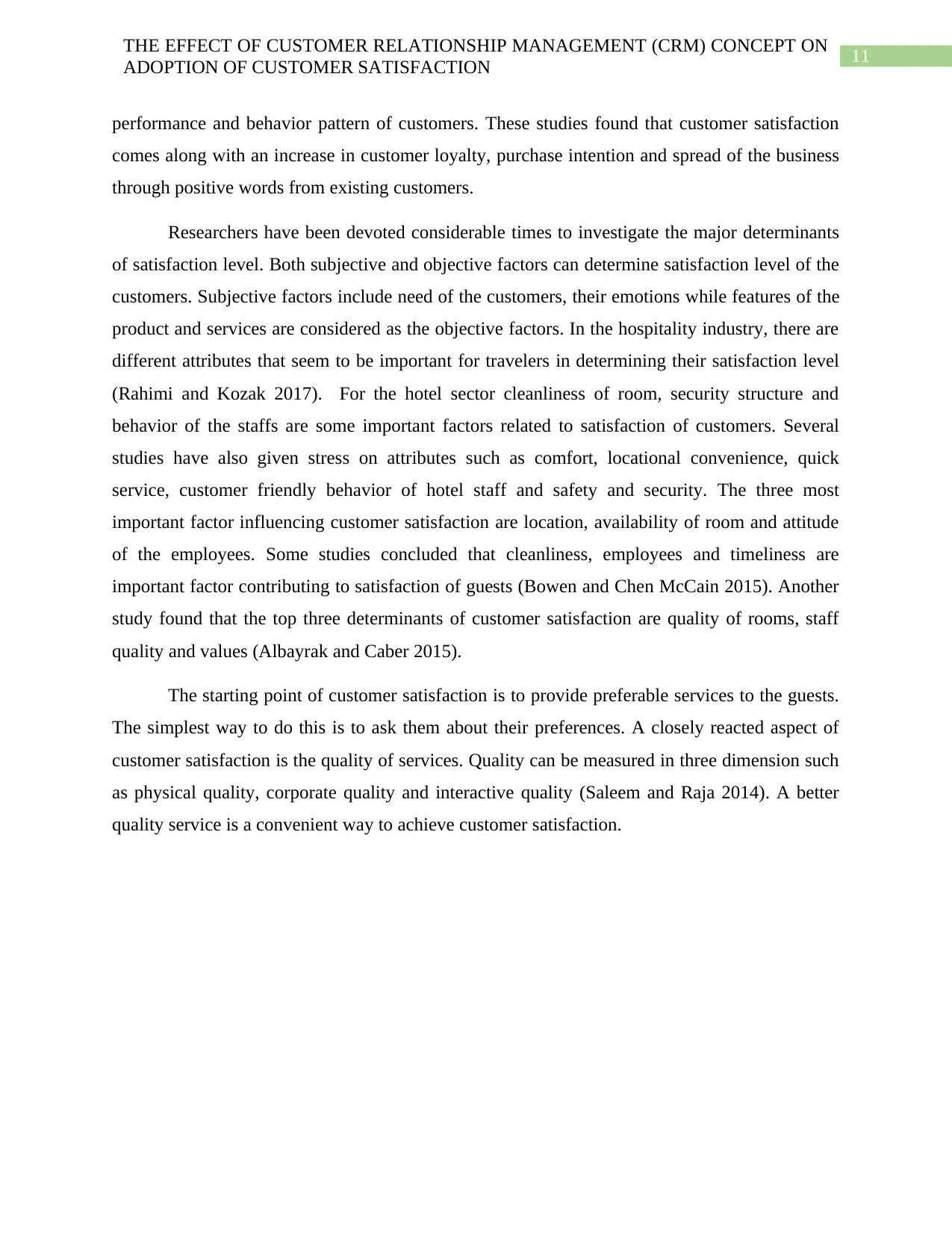
11
THE EFFECT OF CUSTOMER RELATIONSHIP MANAGEMENT (CRM) CONCEPT ON
ADOPTION OF CUSTOMER SATISFACTION
performance and behavior pattern of customers. These studies found that customer satisfaction
comes along with an increase in customer loyalty, purchase intention and spread of the business
through positive words from existing customers.
Researchers have been devoted considerable times to investigate the major determinants
of satisfaction level. Both subjective and objective factors can determine satisfaction level of the
customers. Subjective factors include need of the customers, their emotions while features of the
product and services are considered as the objective factors. In the hospitality industry, there are
different attributes that seem to be important for travelers in determining their satisfaction level
(Rahimi and Kozak 2017). For the hotel sector cleanliness of room, security structure and
behavior of the staffs are some important factors related to satisfaction of customers. Several
studies have also given stress on attributes such as comfort, locational convenience, quick
service, customer friendly behavior of hotel staff and safety and security. The three most
important factor influencing customer satisfaction are location, availability of room and attitude
of the employees. Some studies concluded that cleanliness, employees and timeliness are
important factor contributing to satisfaction of guests (Bowen and Chen McCain 2015). Another
study found that the top three determinants of customer satisfaction are quality of rooms, staff
quality and values (Albayrak and Caber 2015).
The starting point of customer satisfaction is to provide preferable services to the guests.
The simplest way to do this is to ask them about their preferences. A closely reacted aspect of
customer satisfaction is the quality of services. Quality can be measured in three dimension such
as physical quality, corporate quality and interactive quality (Saleem and Raja 2014). A better
quality service is a convenient way to achieve customer satisfaction.
THE EFFECT OF CUSTOMER RELATIONSHIP MANAGEMENT (CRM) CONCEPT ON
ADOPTION OF CUSTOMER SATISFACTION
performance and behavior pattern of customers. These studies found that customer satisfaction
comes along with an increase in customer loyalty, purchase intention and spread of the business
through positive words from existing customers.
Researchers have been devoted considerable times to investigate the major determinants
of satisfaction level. Both subjective and objective factors can determine satisfaction level of the
customers. Subjective factors include need of the customers, their emotions while features of the
product and services are considered as the objective factors. In the hospitality industry, there are
different attributes that seem to be important for travelers in determining their satisfaction level
(Rahimi and Kozak 2017). For the hotel sector cleanliness of room, security structure and
behavior of the staffs are some important factors related to satisfaction of customers. Several
studies have also given stress on attributes such as comfort, locational convenience, quick
service, customer friendly behavior of hotel staff and safety and security. The three most
important factor influencing customer satisfaction are location, availability of room and attitude
of the employees. Some studies concluded that cleanliness, employees and timeliness are
important factor contributing to satisfaction of guests (Bowen and Chen McCain 2015). Another
study found that the top three determinants of customer satisfaction are quality of rooms, staff
quality and values (Albayrak and Caber 2015).
The starting point of customer satisfaction is to provide preferable services to the guests.
The simplest way to do this is to ask them about their preferences. A closely reacted aspect of
customer satisfaction is the quality of services. Quality can be measured in three dimension such
as physical quality, corporate quality and interactive quality (Saleem and Raja 2014). A better
quality service is a convenient way to achieve customer satisfaction.
⊘ This is a preview!⊘
Do you want full access?
Subscribe today to unlock all pages.

Trusted by 1+ million students worldwide
1 out of 24
Related Documents
Your All-in-One AI-Powered Toolkit for Academic Success.
+13062052269
info@desklib.com
Available 24*7 on WhatsApp / Email
![[object Object]](/_next/static/media/star-bottom.7253800d.svg)
Unlock your academic potential
Copyright © 2020–2025 A2Z Services. All Rights Reserved. Developed and managed by ZUCOL.




